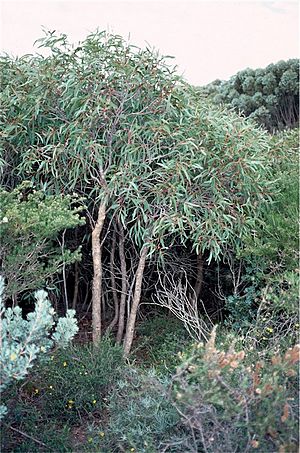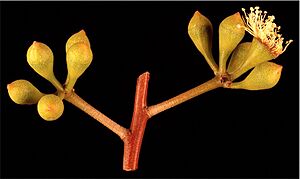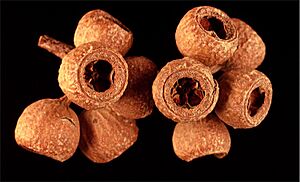Laterite mallee facts for kids
Quick facts for kids Laterite mallee |
|
|---|---|
 |
|
| Eucalyptus lateritica growing near Badgingarra | |
| Conservation status | |
| Scientific classification | |
| Genus: |
Eucalyptus
|
| Species: |
lateritica
|
The Laterite Mallee (scientific name: Eucalyptus lateritica) is a special type of plant found only in a small area of Western Australia. It's called a "mallee" because it's a type of eucalyptus that grows with many stems from the ground, like a bush.
This plant has rough bark on the lower part of its trunk, but the bark higher up is smooth and grey. It has long, narrow adult leaves. Its flower buds grow in groups of nine or eleven, and when they open, they reveal white flowers. After flowering, it produces round, woody fruits.
Contents
What the Laterite Mallee Looks Like
The Laterite Mallee is a type of eucalyptus that usually grows about 2 to 4 meters (about 6 to 13 feet) tall. It has a special woody swelling at its base called a lignotuber. This helps the plant regrow if it gets damaged, for example, by a fire.
The bark on the lower half of the trunk is rough and corky, while the bark higher up is smooth and greyish-brown.
Leaves and Flowers
- Young leaves: When the plant is young, or when new shoots grow from the base (called coppice regrowth), the leaves are shaped like an oval or a spear. They are about 7 to 18 centimeters (about 3 to 7 inches) long and 1 to 3.5 centimeters (about 0.4 to 1.4 inches) wide. Each leaf has a small stalk called a petiole.
- Adult leaves: The adult leaves are a slightly shiny green on both sides and are also spear-shaped. They are about 7 to 12.5 centimeters (about 3 to 5 inches) long and 0.9 to 2 centimeters (about 0.4 to 0.8 inches) wide. They also have a petiole, which is about 1 to 1.8 centimeters (about 0.4 to 0.7 inches) long.
The flower buds grow in groups of nine or eleven. They are attached to a main stalk called a peduncle, which is about 0.8 to 2 centimeters (about 0.3 to 0.8 inches) long. Each individual bud has its own tiny stalk, called a pedicel, about 0.1 to 0.7 centimeters (about 0.04 to 0.3 inches) long.
Mature buds are oval or broadly spindle-shaped, about 0.7 to 1 centimeter (about 0.3 to 0.4 inches) long and 0.5 to 0.7 centimeters (about 0.2 to 0.3 inches) wide. They have a cone-shaped cap called an operculum.
The Laterite Mallee blooms between August and October, and its flowers are white.
Fruit
After the flowers, the plant produces a woody, round fruit called a capsule. These fruits are about 1 to 1.3 centimeters (about 0.4 to 0.5 inches) long and 1.2 to 1.6 centimeters (about 0.5 to 0.6 inches) wide.
How it Got its Name
The Laterite Mallee was first officially described in 1986 by two botanists, Ian Brooker and Stephen Hopper. They found a sample of the plant near Mount Lesueur.
The scientific name lateritica comes from a Latin word meaning "brick-red." This name was chosen because the plant grows in areas with "lateritic gravel," which is a reddish, gravelly soil.
This plant is part of a larger group of mallee species called Diversiformae. Plants in this group all have adult leaves that stand upright, buds with a single cap, and pyramid-shaped seeds.
Where the Laterite Mallee Lives
The Laterite Mallee is found in the Badgingarra and Mount Lesueur areas of Western Australia. It grows on hillsides and flat-topped hills (called mesas) in sandy, gravelly soils that are rich in laterite.
Protecting the Laterite Mallee
The Laterite Mallee is considered "vulnerable." This means it's at risk of becoming endangered if we don't protect it. It's listed as "vulnerable" by the Australian Government and as "Threatened Flora" by the Department of Environment and Conservation in Western Australia.
Some of the main things that could harm this plant include:
- A plant disease caused by a type of water mould.
- Bushfires.
- Damage from insects.
- Animals eating the plants (grazing).
- Weeds growing nearby and competing for resources.
- Mining activities in the areas where it grows.




